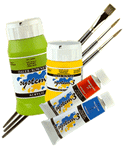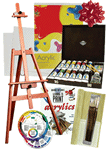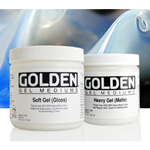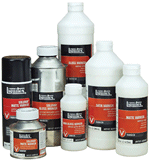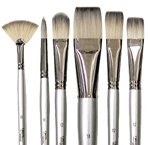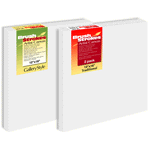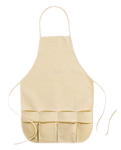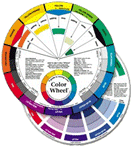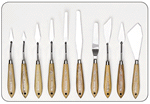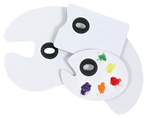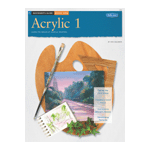SURFACE PREPARATION
APPLICATIONS & TECHNIQUES
The surface, also known as the support or substrate, is the basic substructure of a painting. The type of surface chosen will depend somewhat on the painting style of the artist, the desired visual effect, the purpose of the work, required longevity and the media used.
Rules for choosing and preparing surfaces
- Avoid oily, waxy and hard, shiny surfaces. Some hard shiny surfaces can be prepared by sanding and roughing the surface to provide tooth.
- Never apply acrylics over oil paint.
- Always do a test piece first. Refer to Adhesion Test below.
FLEXIBLE SURFACES
PAPER
Most papers are made and labeled for particular media and require little or no preparation.
Types
- Bristol Board: Papers designed specifically for acrylic painting. Available in single, double ply and in heavier formats.
- Hot Pressed Paper and Hot Pressed Boards have a smooth surface.
- Cold Pressed Paper and Cold Pressed Boards have rough texture. They will accentuate the paint texture or grain of watercolor and airbrush technique.
- For airbrush artists who use self-adhering frisket film, choose papers of adequate surface strength to hold up to cutting and lifting this film.
Surface Preparation
Papers are sometimes sealed prior to painting. This allows the paint that is applied to lie on the surface rather than being absorbed by the paper fibers.
The heavier the weight of paper, the less warping that will occur when painted with acrylic paint. Tape down edges of paper to backing surface while sealing to prevent warping. Do not remove tape until paper has completely dried. Liquitex Gloss Medium & Varnish or Matte Medium allows color of paper to show through.
Liquitex Gesso and/or Liquitex Colored Gesso provides a "tooth" to paper surface and establishes a colored ground.
FABRIC
Liquitex Acrylics can be applied directly on fabrics of both natural and synthetic fibers. The tighter fabric weaves yields brighter the colors when dry.
Types
Liquitex Acrylic Colors are suitable for fabrics such as cotton, cotton/poly blends, woven fabric, knits, felt, suede, leather, terry cloth, silk, velvet, velveteen, corduroy and flannel.
Refer to Part 2 Applications & Techniques: Fabric
Surface Preparation
- Wash fabric first to remove sizing or starch.
- Always do a test piece to ensure compatibility with your materials and application.
Refer to Part I Paint Additives: Flow-Aid Flow Enhancer and Liquitex Acrylic Mediums: Fabric Medium
CANVAS
Canvas is made from cotton, linen, jute and natural or synthetic fibers.
- Canvas is sold by width and by weight.
- The weight describes the thickness of a canvas and refers to the weight of a square yard of the material. (One square yard of 10 ounce duck, for example, weighs 10 ounces.)
- Canvases are available pre-stretched on either standard or heavy-duty stretcher bars.
Types
Pre-Primed Canvas
- Commercially prepared with acrylic gesso or oil ground.
- Available in a variety of natural and synthetic materials and weights, weave patterns and textures.
- Single and double primed versions, which can be further smoothed with more layers of gesso and sanding.
- Primed canvas is more difficult to stretch than raw canvas and requires the use of canvas pliers to stretch.
Raw Canvas
Cotton Duck: The most common canvas used and the most popular style.
Linen: Superior strength and longevity. Lacks the consistency or texture of cotton. Portrait quality linen has the finest and most consistent weave. Although linen is preferred as a "professional" surface, when used for acrylics it offers little benefit over cotton. The high oil content of linen may make it less suitable for use with acrylic gesso and paint.
Jute: Used in applications that call for extreme texture as well as lower price but is not considered a permanent surface and is too textural for most work. Just as with paper, surface texture is an important factor to consider when choosing a canvas.
Synthetic: Most uniform in texture, exceptionally strong and long- lasting. As temperature increases above 900 Fahrenheit some synthetics do not maintain proper surface tension. This is temporary and the canvas usually returns to normal with lower temperatures.
Surface Preparation
Acrylic Medium
Liquitex Gloss Medium & Varnish, Matte Medium or Matte Gel Medium can be used as a sealer (size) for raw canvas. They allow natural color of canvas to be seen after sealing.
Substrate Induced Discoloration (SID) When acrylic mediums are used directly over primed or Unprimed cotton, linen, wood or hardboard, the water content may draw impurities out of the support as it dries. A yellow or brown discoloration in the medium may occur over time. SID will only be noticeable in areas that are left unpainted. It is not a problem if color is mixed with the mediums or if the mediums are over painted with color, SID occurs with all acrylic mediums currently used by major fine art paint manufacturers. Washing the canvas before use can greatly decrease or eliminates SID. The amount of discoloration in the acrylic medium will vary depending upon:
- Quality of the acrylic medium. The unique resin formulation used in all Liquitex Paints and Mediums is clear, flexible and nonyellowing.
- Thickness of the medium application. Gel mediums are more susceptible to SID than fluid mediums. They are thicker, contain more water and take longer to dry.
- Substrate used. Different surfaces contain different colorants and contaminants.
Acrylic Gesso
Liquitex Acrylic Gesso is the highest quality gesso and provides a flexible, non-yellowing ground with excellent tooth for proper paint adhesion. It not only seals and protects the substrate (i.e. canvas) but also provides a ground that will readily accept the application of paint. It is suitable for both oil and acrylic paint applications.
Liquitex Gesso is available in traditional white as well as color versions.
Unbleached Titanium Colored Gesso establishes a colored mid-value tone and provides a background color that is easier for establishing color relationships. A stark white canvas will often fool the eye and cause a number of false starts in making proper color judgments.
Directions
Gesso should be applied to raw canvas after it has been stretched and stapled onto stretcher bars. This ensures a tight surface. Be careful not to stretch the cotton material too tight as considerable shrinking will take place as the gesso dries. Do not use canvas pliers.
Thinning
Liquitex Gesso may be thinned with up to 25% water without adversely affecting adhesion or causing gessoed surface to crack. For increased adhesion and flexibility it is recommended to thin gesso with equal parts water and Liquitex Matte Medium.
Do not over thin gesso with just water, as this may cause surface cracking.
Single Coat vs. Multiple Coat
For standard Cotton Duck canvas, one layer of gesso is often adequate. A second layer will even out and produce a smoother surface. Two layers are recommended when painting with oil paint.
For the most economical multiple coat surface, apply one coat of Liquitex Matte Medium. When dry, apply one coat of Gesso.
Application
Liquitex Gesso can be brushed, troweled or sprayed directly onto raw canvas.
For a brush stroke free surface, apply Liquitex gesso with a large painting knife or squeegee (in half-circular motions) or use a house paint pad. Work the gesso into the weave of the canvas. Let dry, lightly sand with fine-grit sandpaper. Apply second layer.
When spraying it may be necessary to thin gesso. Thin gesso with Liquitex Airbrush Medium approximately 1:1. Add more Airbrush Medium as needed.
Surface
Eggshell Canvas Surface
- Paper smooth canvas surface that is excellent for portrait and airbrush techniques.
- Apply three coats of Liquitex Gesso, allowing each one to dry thoroughly before proceeding to the next.
- Sand between coats with fine sandpaper.
- After the final coat is dry, spray a small area with water and sand in a circular motion with 400-grit wet/dry sandpaper.
- The gesso will take on a paste consistency, filling in the texture of the canvas surface.
- Continue the circular sanding motion until the gesso sets up and dries to an eggshell finish.
- This surface is highly absorbent, causing any paint that is applied to sink rapidly into the surface. If absorbent surface is not desired, apply one or two coats of Liquitex Matte Medium.
- Caution: smooth, wet sanded surfaces of this type tend to be less flexible and more susceptible to impact damage.
Surface Tooth and Absorbency
Dilute Liquitex Gesso with Liquitex Matte Medium to get less absorbency and tooth.
Liquitex Ceramic Stucco, Natural Sand, Resin Sand, Glass Beads Texture Gel, Marble dust or sand, may be mixed into gesso for textural effects. Use caution as too many aggregates may make gesso brittle.
Increasing Absorbency of Gesso
A mixture of 75% Liquitex Gesso and 25% Liquitex Acrylic Modeling Paste will make an Absorbent Gesso, suitable for use as a ground for pastel, charcoal and graphite drawings.
RIGID SURFACES
Rigid surfaces provide smooth or textured surfaces for artists who paint dimensionally and attach objects to rigid surfaces. Most boards can be used as supports to which canvas, paper or other material can be glued. Use Liquitex Matte Gel Medium to adhere canvas to board.
ACETATE
Acetate is a transparent, somewhat brittle plastic available in varying thickness and surface textures.
Matte-surface acetate, textured acetate and wet-media acetate (also called "prepared acetate") are suitable for acrylic paints, mediums and gesso.
Smooth acetate is not recommended, as the surface is smooth and slick.
Wet-media acetate is a clear, smooth acetate that is chemically treated so that acrylic paint, mediums and gesso will not repel away from its surface.
CANVAS PANEL BOARDS
Prepared canvas panel boards are commercially available in a wide variety of sizes and a limited number of surface textures.
They are usually made of cotton canvas wrapped and glued onto heavy cardboard.
Not recommended for permanent work, as they may warp and the glues and papers used in their manufacture may not be permanent.
COMPRESSED HARDBOARDS
Compressed hardboards such as Masonite, are often used as a painting support. Available in a soft (untempered) and a hard (tempered) form, they are not recommended as a permanent support.
Untempered Masonite is subject to warping and is not stable enough for permanent use.
Tempered Masonite is manufactured with silicones and oils that may, in time, affect the adhesion of the paint film to the surface.
If permanence isn't an issue, untempered Masonite may be used. It should be first reinforced with a backing frame glued to the unfinished side. Seal all sides and back with a barrier varnish such Liquitex Soluvar Matte Varnish. Prepare the top (shiny) surface by sanding to a dull finish and covering with at least two coats of gesso. Sand between coats and apply the second coat at right angles to the first.
FIBERGLASS
Fiberglass can be painted with acrylics or oils if the surface is prepared properly.
Sand/sandblast the surface; Remove dust.
Coat with an industrial primer-sealer meant for use with water-based media.
After the primer is completely dry, test for proper adhesion (see Adhesion Test).
Spray or brush on Liquitex Gesso. Let dry overnight. Test for proper adhesion.
FOAM BOARD
Provides a smooth, inert, stable, uniform surface, but they are very susceptible to warping and impact damage.
Lightly sand the surface with very fine sandpaper and apply one or two coats of gesso. Sand between coats. Let dry overnight.
MASONRY AND CONCRETE
There must be no waterproofing, cement paint or silicones on surface. These materials are often used during construction and can adversely effect the longevity of the paint.
Masonry and concrete must be thoroughly dry and cured. This may take 8-12 weeks after set-up. All moisture must be gone or acrylic paint adhesion will not be permanent.
Liquitex Acrylics can be applied directly to a masonry wall, but it is best to first trowel on a layer of Liquitex Matte Gel Medium. This provides an excellent ground for the paint, seals the rough texture of the wall and reduces the amount of paint needed to paint surface.
Let Matte Gel Medium fully dry, then apply one or two coats of gesso. Let dry overnight.
METAL AND GLASS
Sand with 400-grit paper or sandblast for proper paint film adhesion.
Aluminum should be etched with a 5% lye solution for 4 to 5 minutes.
Glass can be acid-etched or sand blasted.
Directions for metal
Wipe surface with a degreasing solution and coated with an industrial primer meant for use with water-based media.
After the primer is completely dry, test for proper adhesion (see Adhesion Test)).
Spray or brush apply Liquitex Gesso. Let dry for 3 days and test for adhesion.
MURALS
Murals cover a variety of techniques, including fresco, encaustic, mosaic, stained glass and photography. The type of mural technique most used is either painting on canvas, which is then attached to a wall or painting directly on the surface of the wall itself.
When painting directly on any wall, there must be no grease, wax or oil on the surface. It needs to be structurally sound and free of loose particles.
Refer to Part 2 Applications & Techniques:Murals
MYLAR
Mylar is a film that has all the properties and uses of acetate with additional flexibility and strength. Much higher in price than acetate, it does not stretch, crack or yellow and is also available with a photosensitive surface for the reproduction of line drawings.
Like acetate, Mylar is available in a wet-media form that needs no surface preparation.
PLASTERBOARD
Do not use if previously painted with oil paint.
Prepare the surface by sealing it first with an industrial primer/sealer like Aqualock, made for use with water base paints.
When sealer is dry, apply two coats of gesso with a brush, spray or paint pad.
PLASTIC PANELS (PLEXIGLAS)
Depending upon the type of plastic, acrylic paint can be applied directly to the surface. Some plastics will repel acrylic paint, some are very smooth and the acrylic paint will easily scratch off and some have a slight tooth and provide the best surface for paint adhesion. The plastic must be chemically inert so that it will not react with the paint film over time.
For the most permanent acrylic paint
application, sand the entire panel or sand only those areas that will be painted, to preserve the transparent nature of the product.
After sanding, coat with a layer of Liquitex Matte Medium or Matte Gel Medium and one or two coats of Liquitex Gesso.
Plexiglas is an acrylic sheet material manufactured in a variety of widths. When sanded, it will provide adequate surface tooth for acrylic paint. Both sides of the sheet can be painted to yield dimensional qualities.
When working with transparent colors use Liquitex Gloss Medium & Varnish or Gel Medium to maintain clarity.
PLYWOOD
MDO Boards are varieties of plywood that are bonded with paper on one or both sides, available from sign making supply houses. They offer a very smooth surface quality that is hard to achieve with standard plywood.
Negative aspects- weight.
Good exterior grade plywood or birch plywood provides an excellent painting support.
Plywood is available in 1/8" thickness (called "door skin") of mahogany, birch, maple and oak. The harder woods, such as birch, maple and oak will require less gesso to seal and provide a smooth surface. Plywood sheets may be adhered to wooden stretcher bars for added strength and to prevent warping. Glue and nail plywood to stretcher bars every 3-4".
All forms of plywood will require between 2-5 coats of gesso.
UNUSUAL SURFACES
Unusual surfaces should be tested for compatibility with the acrylic paint. Certain paint and surface combinations may react with one another over time.
The type of surface and ground used with acrylic paint has a large effect on how the paint handles.
ADHESION TEST
- The following surface preparation procedures serve as a general guideline for most acrylic paint applications. Surfaces should be tested for adhesion and compatibility of material. Directions
- Apply the paint or medium to prepared surface and let dry thoroughly. Wait 72 hours for acrylic paint to cure before continuing. (longer in humid conditions).
- When completely dry, score surface in a crosshatch pattern using a sharp knife.
- Apply masking tape to surface & burnish.
- Remove masking tape slowly.
- If any paint comes off with the tape, good surface adhesion has not been achieved. Either a different surface preparation is necessary or the particular support is not suitable for the paint or medium tested.


